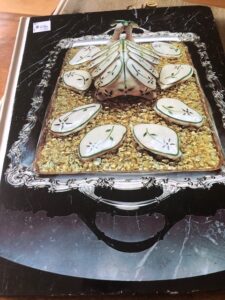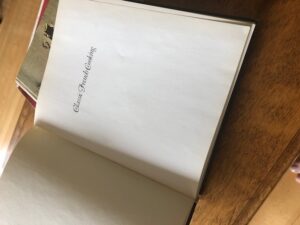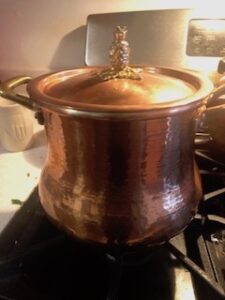More of these fabulous books keep arriving. I find these Time-Life Foods of the World books used, often for as little as a dollar with free shipping. (I actually don’t know how this is possible.)
I know that the first volume was published in 1968 and that it was The Foods of Provincial France and that it started a Foodie uproar. Craig Claiborne was outraged by even the cover which featured what I believe to be a soufflé but what Claiborne said was a fake soufflé replaced by a meringue. The horror! The deception! That first volume had a whole crew of big hitters on its team, including Julia Child in a sort of advisory capacity and MFK Fisher as the chief writer for the hard bound volume. And actually it’s a pretty good cookbook even if someone did take out one of those mini sized blow torches to brown the top of the starring dish.

Two years later, after the publication of a volume on the Cooking of China, a second text on French cooking was published in the series. Classic French Cooking was edited by Craig Claiborne (!), with editorial assistance from James Beard and Jacques Pepin and published in 1970 (when I was still in high school). Two days ago I received a used volume.

Even though I wanted to, I just didn’t love this book the way I did The Cooking of Spain and Portugal. The Iberian volume is written in first person and is a kind of love letter/memoir to the region with beautiful and often simple recipes. There’s lot of Spanish and Portuguese history and many allusions to literature and poetry, but it reads personally and affectively. If the truth be told, Classic French Cooking is just a little stuffy (actually more than a little). Craig Claiborne describes the transcendent delights of haute cuisine in a grand and distant manner, cautioning the reader that he is in a “world beyond the realm of every day cooking.” One senses, on the part of Claiborne and associates that there is a vast nostalgia for France’s grand nineteenth Belle Epoque. (Marion Cottilard”s character in Midnight in Paris could have written this book.) Even when the author (s) describes a dinner in the first person, it all feels a little over done and dated. (Which is quite unlike the Spain and Portugal book.) Claiborne describes a French style dinner with a young couple in Connecticut and along with the discussion of the carpet, the sauces and the 150 year old Cognac, mentions that they had employed a butler for the occasion as they generally did when they had company.
Excuse me? A butler? In 1970? Even Julia Child recognized that most American households didn’t employ servants.
Don’t get me wrong. Reading this book was highly informative and entertaining. I learned a great deal about sauces and the origins of French cuisine. But I didn’t love it.
There are just too many dishes with perfectly poached eggs encased quiveringly in aspic, too much gelatin in general (I never even liked Jello), and too many strange organ meats. There are also a great many platters that are mostly for display, buildings made of gelatin (again) and pigeon breasts, classical reproductions, and birds encased within birds encased within birds. Sauces are everywhere and there isn’t a lot of anything green.
And I have to be honest. Even though I love and revere Julia C she too has a great deal of gelatin and organ meat in her books. I mean, I live in California. We eat salads and avocado toast. Classic cuisine feels heavy and, frankly, quite dated in a way that the foods of Provence and Spain and Portugal do not. But now I understand all those food revolutions in France in the 1970s.
But along with talking about the contents of the books I have to make a small confession. Two of these used volumes have come with address stickers on the inside of the covers. You know those old stickers that our mothers used to get, printed with Mrs. whatever the husband’s name was and the return address? Well, I googled the names and addresses. In both cases, the original owner of the book was deceased and in one case a granddaughter was currently dealing with the estate. Obviously the books had either been donated somewhere or sold at estate sales. At first I thought this was kind of creepy and sad.
But then I found something rather beautiful about it all. People had owned these books and felt sufficient fondness for them to keep them throughout their lives. Now I’m cooking some of the same recipes. I feel as though there’s a spirit, of the books’ authors and also of the original owners that travels lovingly with the texts. It’s a visceral connection, via food, tying me to people I didn’t know before. I’m telling you, there’s something magical about this book series.
If Covid ever ends and I ever go to parties again I will be able to talk informatively about the origins of. European cuisine, the impact of Italian food on France and the fact that although the ill-fated Louis XVI wasn’t a very popular king he was at least an excellent eater, ordering a large formal meal for himself immediately before his beheading.
Reading these books is way better than binge watching T.V., even if what one is watching is Call My Agent or something equally fabulous.

I have two more volumes waiting for me: the foods of India and China.
Bon Appetit!